What is a "macronutrient"?
Author: Courtney Moore MS, RD
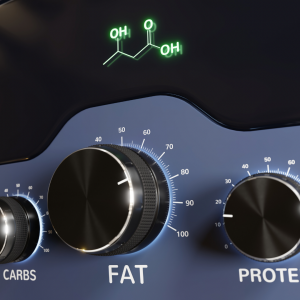
Macronutrients...Macros...IIFIYM...Carbs....Protein...Fats. These words may be somewhat familiar, but what are they really? What do macronutrients real do and why are they all so important and such hot topics year to year? This blog post is to hopefully provide some clarity.
Here are some of the basics:
-
There are 3 macronutrients: Protein, Carbohydrates and Fat. All foods are made of and will be broken down into these 3 macronutrients.
- Protein, carbohydrate and fat are all crucial for our bodies to function at their best but they are all very different.
- The human body calls upon different levels of protein, carbohydrate and fat in order to fuel our bodies to work at the optimal level. The human body is fascinating and the way it works is more intricate than any machine or computer made. Each macronutrient plays very different roles in the body.
Let’s break down each of the macronutrients and why they are all an integral part of body function.
Carbohydrates
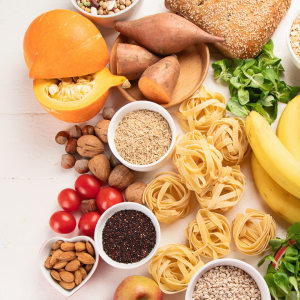
First up, carbohydrates. These are the body’s main source of fuel and are easily used by the body for quick energy. Carbs are converted to glucose in the body and all tissues and cells in our body can use glucose for energy. Our bodies do not have to work very hard to convert carbohydrates to energy (which is a good thing). Carbohydrates are needed for the central nervous system, the brain, the muscles (including the heart) to function properly.
Fun fact: the brain’s primary source of fuel is glucose; it cannot be stored here and therefore, requires a consistent source of fuel.
Carbs also provide energy so the body can preserve protein use for its proper functions and preserve lean muscle mass. If the energy consumed from carbohydrates are not immediately needed, our bodies can store glucose in the muscles and liver and later used for energy. Carbs also play a large role in gut health. So, where can we find good sources of carbs? Good sources of carbohydrates include grains, starchy vegetables (potatoes, peas, corn), fruits, milk, yogurt. For every 1 gram of carbohydrate, there are 4 calories.
Protein
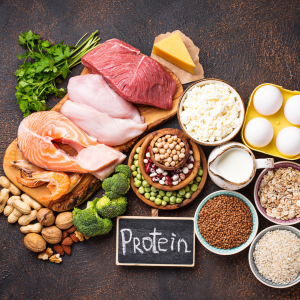
Protein is up next, and protein has a pretty good reputation – as it should! Protein is crucial for growth, structure and maintenance of body tissues and every day function. Think: muscle growth, tissue repair, day-to-day degradation/turnover, injury, post-illness, etc. Proteins act as building blocks for almost all things in the body. Proteins are needed for healthy hormone and enzyme function. They are utilized in thousands of biochemical processes that occur daily throughout the body (digestion, metabolism, energy production/conversion, cell reproduction, organ function, reproductive function, etc.). They also act as messengers and help with communication throughout our body with hormones. Lastly, they help form antibodies which help our bodies fight off infection.
Fun fact: Protein can be used as an energy source when carbohydrates are not available, but this is not ideal, as it causes our bodies to dip into our lean body mass to convert to energy (and we want to preserve those muscles!).
Protein rich foods include meat, fish, low-fat cheese, greek yogurt, etc. Similar to carbohydrates, 1 gram of protein provides 4 calories.
Fat
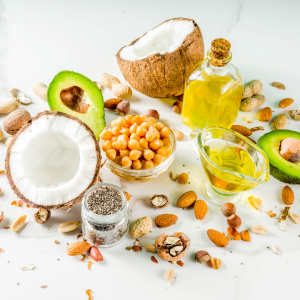
Last, but certainly not least is fat. Fat used to get a bad rap, but it has recovered in the last 20+ years. Fat is a great source of energy; it is the most concentrated source and longer-lasting source. It is necessary for the absorption of the “fat soluble” vitamins (vitamins A, D, E, K). Some types of fat (omega-3) have anti-inflammatory properties and help fight disease. Fat plays a role in cell membranes, which helps keep our nerves and brains functioning well. Fat also keeps us full, cues satiety and helps communicate to our brain that we are full.
Fun fact: There are essential fats (essential fatty acids) that help make our bodies work- we cannot make them on our own. Sources of heart healthy fat include nuts, avocado, olive oil, olives, seeds and fatty fish (salmon, mackerel, etc.).
Fat provides the most amount of energy per gram; 1 gram of fat provides 9 calories.
In summary
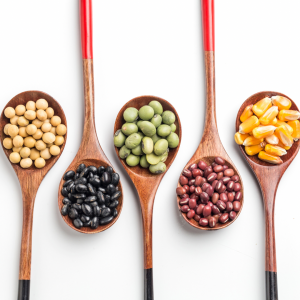
As one can imagine, if you take out one of these three macronutrients, our bodies are not able to function at its best. Our bodies are efficient and will try to fill the gaps where it can, but while doing that, it is taking away from other functions. Omitting or avoiding one of these 3 macronutrients is like taking the third leg off of a stool – it’s not going to work out best. Here’s to enjoying all three of these macronutrients and fueling our bodies to help them work and feel the best we can!

 RSS Feed
RSS Feed